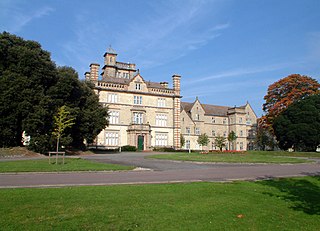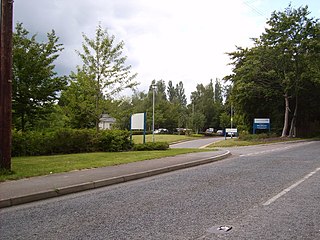
Broadmoor Hospital is a high-security psychiatric hospital in Crowthorne, Berkshire, England. It is the oldest of the three high-security psychiatric hospitals in England, the other two being Ashworth Hospital near Liverpool and Rampton Secure Hospital in Nottinghamshire. The hospital's catchment area consists of four National Health Service regions: London, Eastern, South East and South West. It is managed by the West London NHS Trust.

Rampton Secure Hospital is a high-security psychiatric hospital near the village of Woodbeck between Retford and Rampton in Nottinghamshire, England. It is one of three high-security psychiatric hospitals in England, alongside Ashworth Hospital in Merseyside and Broadmoor Hospital in Berkshire. It is managed by Nottinghamshire Healthcare NHS Foundation Trust.

Shelton is a suburb located in the west of the town of Shrewsbury in Shropshire, England, described by the Pevsner Architectural Guides as "Shrewsbury's principal interwar suburb."

The Countess of Chester is the main NHS hospital for Chester and its surrounding area. It currently has 625 beds, general medical departments and a 24-hour accident and emergency unit. It is managed by the Countess of Chester Hospital NHS Foundation Trust, one of the first Foundation Trusts in the UK, formed in 2004. Cardiac rehabilitation services at the hospital are provided by Cheshire and Wirral Partnership NHS Foundation Trust.

Fulbourn Hospital is a mental health facility located between the Cambridgeshire village of Fulbourn and the Cambridge city boundary at Cherry Hinton, about 5 miles (8 km) south-east of the city centre. It is managed by the Cambridgeshire and Peterborough NHS Foundation Trust. The Ida Darwin Hospital site is situated behind Fulbourn Hospital. It is run and managed by the same trust, with both hospitals sharing the same facilities and staff pool.

Gartnavel Royal Hospital is a mental health facility based in the west end of Glasgow, Scotland. It provides inpatient psychiatric care for the population of the West of the City. It used to house the regional adolescent psychiatric unit but this has recently moved to a new psychiatric unit at Stobhill Hospital. The Hospital is a venue used by the Mental Health Tribunal for Scotland. Some parts of the hospital are classified as a category A building and are also deemed at risk.

Cefn Coed Hospital is a mental-health facility in Swansea, Wales. It is managed by the Swansea Bay University Health Board.

The Royal Shrewsbury Hospital is a teaching hospital in Shrewsbury, Shropshire, England. It forms the Shrewsbury site of the Shrewsbury and Telford Hospital NHS Trust, serving patients from Shropshire and Powys, in conjunction with the Princess Royal Hospital in Telford.

St Nicholas Hospital is an NHS psychiatric hospital located in Gosforth, Newcastle upon Tyne, England, UK. The entrance is located on Jubilee Road. The buildings range from Victorian-era to modern facilities and occupies 12 hectares of land. It is managed by Cumbria, Northumberland, Tyne and Wear NHS Foundation Trust.

Springfield University Hospital is a psychiatric hospital in Tooting, South London and also the headquarters of the South West London and St George's Mental Health NHS Trust.

Blackberry Hill Hospital is an NHS psychiatric hospital in Fishponds, Bristol, England, specialising in forensic mental health services, operated by the Avon and Wiltshire Mental Health Partnership NHS Trust. The hospital also offers drug and alcohol rehabilitation inpatient services, and is the base for a number of community mental health teams.
Shrewsbury and Telford Hospital NHS Trust is the main provider of hospital services for Shropshire, Telford and Wrekin and North Powys. It runs the Royal Shrewsbury Hospital, the Princess Royal Hospital in Telford, Oswestry Maternity Unit, and Wrekin Community Clinic, Euston House, Telford, in Shropshire, England. It is one of a small number of English NHS Trusts which takes patients from over the border in Wales.
Mental health in the United Kingdom involves state, private and community sector intervention in mental health issues. One of the first countries to build asylums, the United Kingdom was also one of the first countries to turn away from them as the primary mode of treatment for the mentally ill. The 1960s onwards saw a shift towards Care in the Community, which is a form of deinstitutionalisation. The majority of mental health care is now provided by the National Health Service (NHS), assisted by the private and the voluntary sectors.
Roseberry Park Hospital is a mental health facility in Middlesbrough, North Yorkshire, England, run by the Tees, Esk and Wear Valleys NHS Foundation Trust.

Cherry Knowle Hospital was a mental health facility in Ryhope, Tyne and Wear, England. It was managed by the South of Tyne and Wearside Mental Health NHS Trust.

Littlemore Hospital was a mental health facility on Sandford Road in Littlemore, Oxfordshire.

St George's Hospital is a mental health facility in Stafford, Staffordshire, England. The main building is no longer in use but survives and is a Grade II listed building.

St James' Hospital is a mental health facility at Milton, Portsmouth, Hampshire, England. It is managed by Solent NHS Trust. The main structure is a Grade II listed building.

Dykebar Hospital is a mental health facility in Dykebar, Paisley, Renfrewshire, Scotland. The main building is a Grade B listed building. The hospital is managed by NHS Greater Glasgow and Clyde.

Tatchbury Mount Hospital is a health facility to the north of Totton, Hampshire, England. It is owned and managed by Southern Health NHS Foundation Trust and acts as the Trust's headquarters. The site was formerly a large psychiatric hospital with the majority of the buildings on the site dedicated to this purpose, however in recent years changes in the management of these patients has resulted in the uses for the site diversifying.


















